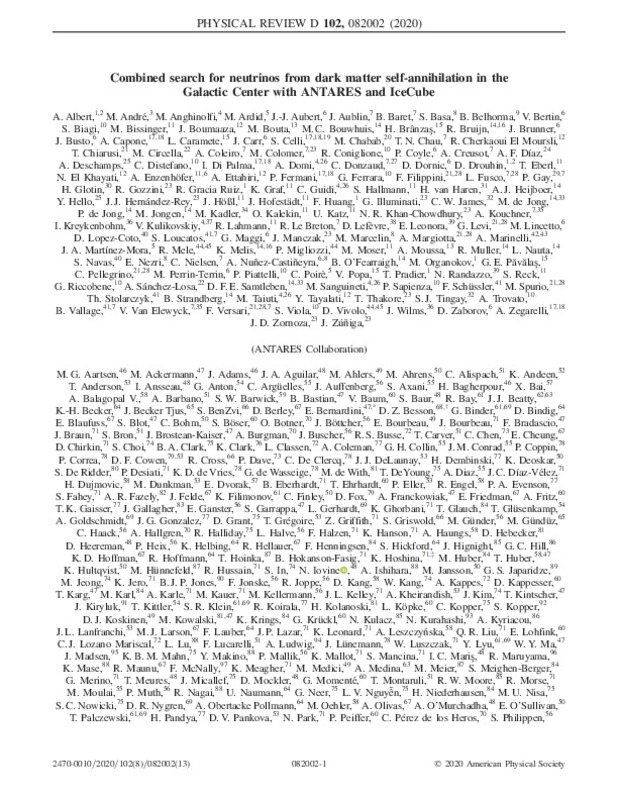|
Resumen:
|
[EN] We present the results of the first combined dark matter search targeting the Galactic Center using the ANTARES and IceCube neutrino telescopes. For dark matter particles with masses from 50 to 1000 GeV, the sensitivities ...[+]
[EN] We present the results of the first combined dark matter search targeting the Galactic Center using the ANTARES and IceCube neutrino telescopes. For dark matter particles with masses from 50 to 1000 GeV, the sensitivities on the self-annihilation cross section set by ANTARES and IceCube are comparable, making this mass range particularly interesting for a joint analysis. Dark matter self-annihilation through the ¿+¿¿, ¿+¿¿, b¯b, and W+W¿ channels is considered for both the Navarro-Frenk-White and Burkert halo profiles. In the combination of 2101.6 days of ANTARES data and 1007 days of IceCube data, no excess over the expected background is observed. Limits on the thermally averaged dark matter annihilation cross section h¿A¿i are set. These limits present an improvement of up to a factor of 2 in the studied dark matter mass range with respect to the individual limits published by both collaborations. When considering dark matter particles with a mass of 200 GeV annihilating through the ¿þ¿¿ channel, the value obtained for the limit is 7.44 × 10¿24 cm3 s¿1 for the Navarro-Frenk-White halo profile. For the purpose of this joint analysis, the model parameters and the likelihood are unified, providing a benchmark for forthcoming dark matter searches performed by neutrino telescopes.
[-]
|
|
Agradecimientos:
|
The authors from the ANTARES Collaboration acknowledge the financial support of the following funding agencies: Centre National de la Recherche Scientifique (CNRS), Commissariat a l'energie atomique et auxenergies alternatives ...[+]
The authors from the ANTARES Collaboration acknowledge the financial support of the following funding agencies: Centre National de la Recherche Scientifique (CNRS), Commissariat a l'energie atomique et auxenergies alternatives (CEA), Commission Europeenne (FEDER fund and Marie Curie Program), Institut Universitaire de France (IUF), IdEx program and UnivEarthS Labex program at Sorbonne Paris Cite (ANR-10-LABX-0023 and ANR-11IDEX-0005-02), Labex OCEVU (ANR-11-LABX-0060) and the A*MIDEX project (ANR-11-IDEX-0001-02), Region Ile-de-France (DIM-ACAV), Region Alsace (contrat CPER), Region Provence-Alpes-Cote d'Azur, Departement du Var and Ville de La Seyne-sur-Mer, France; Bundesministerium fur Bildung und Forschung (BMBF), Germany; Istituto Nazionale di Fisica Nucleare (INFN), Italy; Nederlandse organisatie voor Wetenschappelijk Onderzoek (NWO), the Netherlands; Council of the President of the Russian Federation for young scientists and leading scientific schools supporting grants, Russia; Executive Unit for Financing Higher Education, Research, Development and Innovation (UEFISCDI), Romania; Ministerio de Ciencia, Innovacion, Investigacion y Universidades (MCIU): Programa Estatal de Generacion de Conocimiento (refs. PGC2018-096663-B-C41, -A-C42, -B-C43, -B-C44) (MCIU/FEDER), Severo Ochoa Centre of Excellence and MultiDark Consolider (MCIU), Junta de Andalucia (ref. SOMM17/6104/UGR), Generalitat Valenciana: Grisolia (ref. GRISOLIA/2018/119), Spain; Ministry of Higher Education, Scientific Research and Professional Training, Morocco. We also acknowledge the technical support of Ifremer, AIM and Foselev Marine for the sea operation and CC-IN2P3 for the computing facilities. The authors from the IceCube Collaboration gratefully acknowledge the support from the following agencies and institutions: USA-U.S. National Science Foundation-Office of Polar Programs, U.S. National Science Foundation-Physics Division, Wisconsin Alumni Research Foundation, Center for High Throughput Computing (CHTC) at the University of Wisconsin-Madison, Open Science Grid (OSG), Extreme Science and Engineering Discovery Environment (XSEDE), U.S.
Department of Energy-National Energy Research Scientific Computing Center, Particle astrophysics research computing center at the University of Maryland, Institute for Cyber-Enabled Research at Michigan State University, and Astroparticle physics computational facility at Marquette University; Belgium-Funds for Scientific Research (FRS-FNRS and FWO), FWO Odysseus and Big Science programmes, and Belgian Federal Science Policy Office (Belspo); Germany-Bundesministerium fur Bildung und Forschung (BMBF), Deutsche Forschungsgemeinschaft (DFG), Helmholtz Alliance for Astroparticle Physics (HAP), Initiative and Networking Fund of the Helmholtz Association, Germany-Deutsches Elektronen Synchrotron (DESY), and High Performance Computing cluster of the RWTH Aachen; Sweden-Swedish Research Council, Swedish Polar Research Secretariat, Swedish National Infrastructure for Computing (SNIC), and Knut and Alice Wallenberg Foundation; Australia-Australian Research Council; Canada-Natural Sciences and Engineering Research Council of Canada, Calcul Quebec, Compute Ontario, Canada Foundation for Innovation, WestGrid, and Compute Canada; Denmark-Villum Fonden, Danish National Research Foundation (DNRF), Carlsberg Foundation; New Zealand-Marsden Fund; Japan-Japan Society for Promotion of Science (JSPS) and Institute for Global Prominent Research (IGPR) of Chiba University; Korea-National Research Foundation of Korea (NRF); Switzerland-Swiss National Science Foundation (SNSF); United Kingdom-Department of Physics, University of Oxford. The IceCube collaboration acknowledges the significant contributions to this manuscript from Sebastian Baur, Nadege Iovine and Sara Rebecca Gozzini.
[-]
|









